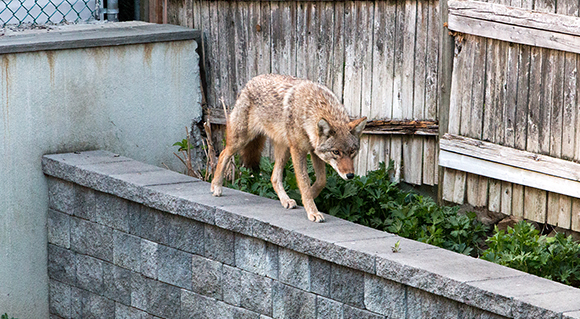Be Coyote Smart
Coyotes are common throughout New York State, including urban areas. Recent sightings confirm that coyotes live in New York City and are active in the Bronx.
Seeing a coyote for the first time can be an exhilarating or an alarming experience. If you see a coyote, do not panic. Most coyotes are not dangerous to people. Nationwide, only a handful of coyote bites are reported each year.
Recognizing a Coyote
Coyotes are canines, which means that they are members of the same genus as wolves and domesticated dogs. In general, coyotes appear “sleeker” than domesticated dogs, with a flatter forehead and a more pointed snout. Coyotes appear to have longer legs than domesticated dogs, while dogs appear to have deeper chests. Also, they have very different tracks. Coyote tracks are more elongated, and they place their front and back paws in alignment when they walk.
Five Easy Tips for Coexisting with Coyotes
Do Not Feed Coyotes. Keeping coyotes wild is the key to coexistence. Their life and your safety depend upon coyotes remaining naturally wary of people.
Remove Attractants. Store food, pet food, and garbage in animal proof containers. Do not leave food or garbage behind in a park.
Supervise Pets. Walk dogs on a leash and keep cats inside for safety.
Keep Coyotes Wary. If you are approached, act big and make loud noises until the coyote retreats.
Appreciate Coyotes. From a distance. Stay at least 150 feet (45 meters) or more from the animal.
When to Report a Coyote Sighting
Most coyotes are not dangerous to people. If you spot an aggressive or fearless coyote in a park, report it immediately to Parks personnel. In case of a medical emergency, such as a bite from or physical contact with a coyote, please call 911.
Coyote Facts
Coyotes are not strictly nocturnal. They may be observed during the day, but are generally more active after sunset and at night.
You may see and hear coyotes more during mating season (January – March) and when the young are dispersing from family groups (October – January).
Coyotes eat what is prevalent and easy to find, shifting their diet to what is seasonally or locally available, including rodents, birds, vegetation, insects and carrion.
Coyotes are naturally wary of people but can habituate to the food sources we provide and our presence.
Information on this page is adapted from Project Coyote. Visit www.projectcoyote.org for more information.
© 2020 The Juniper Park Civic Association Inc. All Rights Reserved.
SERVING MIDDLE VILLAGE AND MASPETH SINCE 1938.




